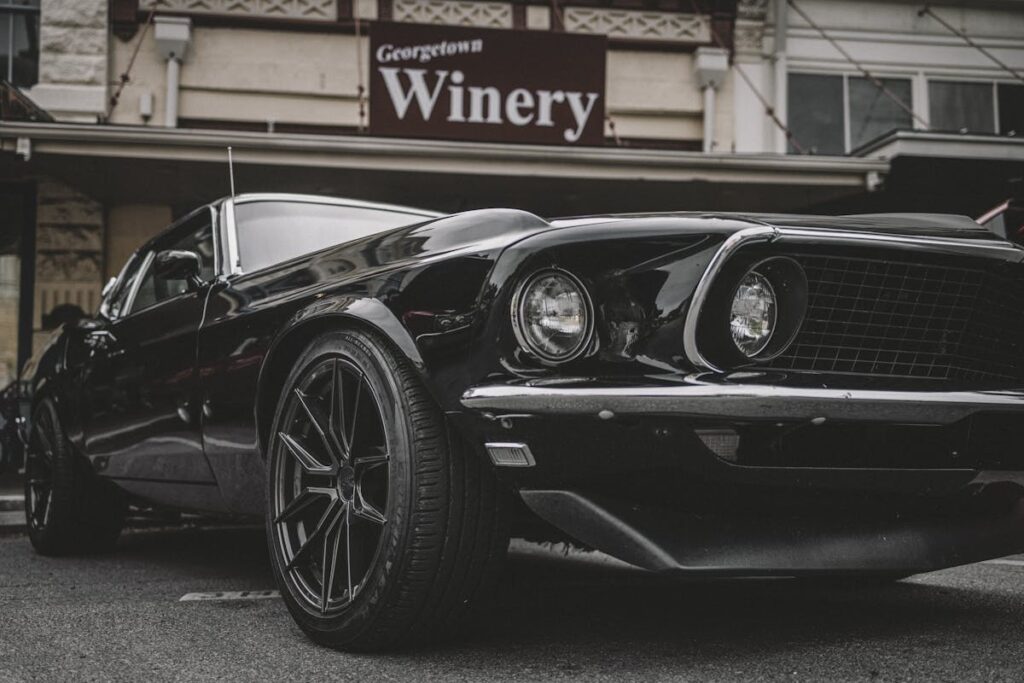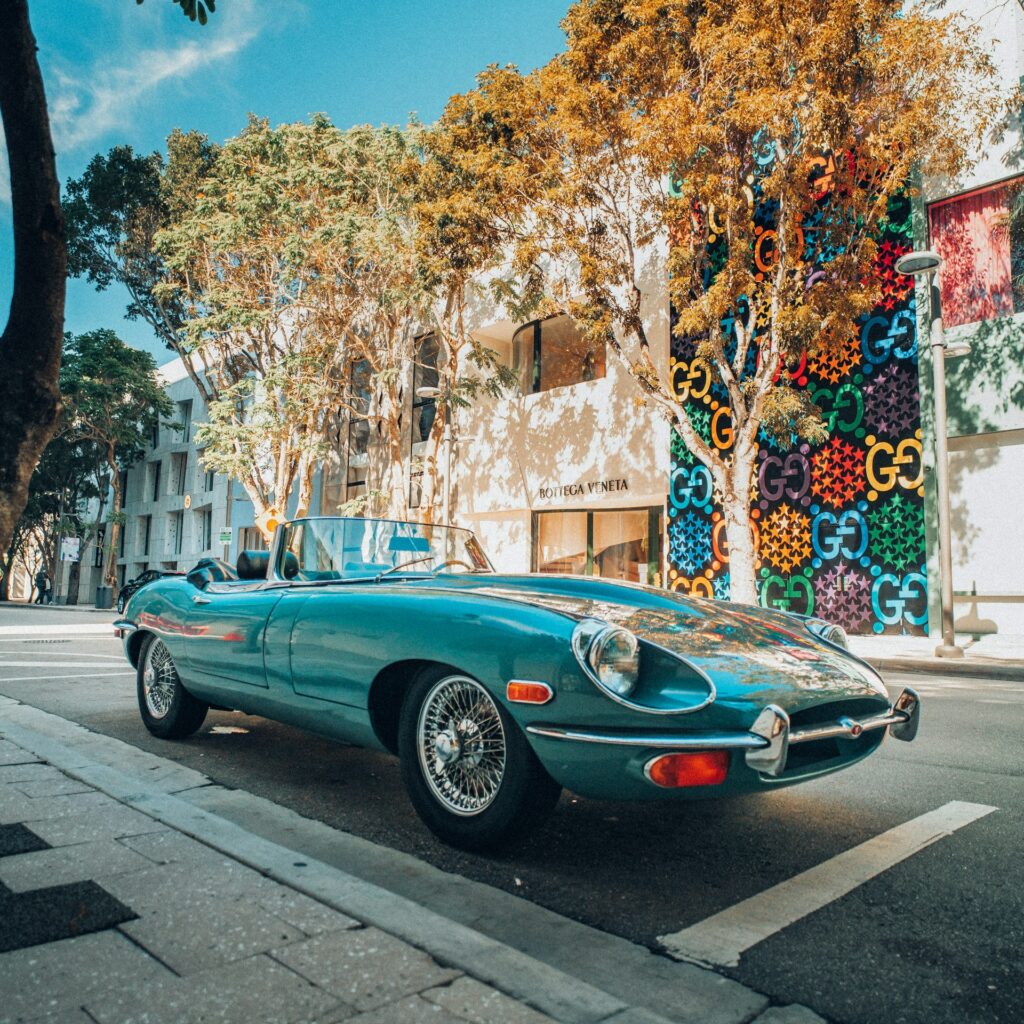The domain of luxury and exotic classic cars offers an enthralling exploration into unparalleled design, intricate craftsmanship, and a rich tapestry of automotive history. These vehicles, often considered moving works of art, stir profound nostalgia and emotional connections among aficionados. Yet, beyond their aesthetic appeal and the prestige they confer, classic cars also represent intriguing investment potential due to their appreciating value in a dynamic market. The intricate details of this fascinating world await further exploration.
Key Takeaways
- Luxury and exotic classic cars, including brands like Ferrari, Lamborghini, and Rolls-Royce, are admired for their timeless design, exceptional performance, and meticulous craftsmanship.
- These cars are often viewed as art pieces, reflecting vintage design philosophies, and are prized for their original paint, fabrics, and mechanical parts.
- The market for exotic classic cars has grown significantly, offering potential investment opportunities with appreciation rates often exceeding traditional investments.
- Preserving these vintage vehicles requires regular maintenance, knowledge of restoration techniques, and proper storage to protect against environmental damage.
- Technological innovations in the automotive industry have led to a rise in electric classic cars, merging past elegance with eco-friendly innovation, and sparking debates about preservation versus modernization.
The Allure of Classic Luxury Cars
Few vehicles stir the senses and capture the imagination quite like classic luxury cars. These automobiles, with their timeless design and exceptional performance, are more than just modes of transportation. They are works of art, symbols of a bygone era that continue to evoke an emotional connection among car enthusiasts worldwide.
The allure of these vehicles is multifaceted, anchored in their distinctive aesthetic appeal and superior engineering. Classic luxury cars were crafted with a meticulous attention to detail, from the sleek lines of their exteriors to the plush materials and intricate detailing of their interiors. Every aspect of their design exudes elegance and sophistication, a demonstration of the craftsmanship of their time.
But the appeal of classic luxury cars goes beyond their physical attributes. Many of these vehicles have fascinating histories, having been associated with high-profile personalities or pivotal moments in automotive history. They also represent a feeling of nostalgia, a longing for a time when driving was a luxurious experience and the journey was just as important as the destination.
The emotional connection that these vehicles inspire is a significant part of their allure. Each classic luxury car has its own unique story, and it’s this narrative that captivates and enchants admirers, adding a rich layer of depth to their timeless design.
Iconic European Exotic Cars
The world of iconic European exotic cars is one steeped in tradition, innovation, and a relentless pursuit of excellence. Italian Masterpieces such as Ferrari and Lamborghini, with their sleek lines and fiery heartbeats, epitomize this pursuit. Their designs are often inspired by the world of Vintage Racing, merging beauty with performance in a breathtaking dance.
German Engineering, embodied in brands like Porsche and Mercedes-Benz, showcases an unparalleled commitment to precision and durability. These vehicles, with their refined powertrains and advanced technology, have made a significant Cultural Impact, shaping our perception of luxury and performance.
British Elegance personified by Aston Martin and Rolls-Royce, French Design with its avant-garde approach seen in Bugatti and Citroen, Spanish Classics like SEAT, and Scandinavian Innovations from Volvo and Koenigsegg all contribute to this diverse and rich tapestry of European exotic cars.
Restoration Techniques have also evolved, keeping these beauties alive and driving. Collector Communities worldwide cherish these vehicles, preserving their heritage while celebrating their continuing relevance. Indeed, the world of iconic European exotic cars is not just about motoring; it’s about history, culture, and a passion that transcends generations.
Anatomy of an Exotic Classic Car
Diving into the anatomy of an exotic classic car, we commence a journey that is both fascinating and complex. The engine specifications of these vehicles are often awe-inspiring, featuring intricate mechanics that exemplify the pinnacle of automotive engineering during their era. The interior craftsmanship, a demonstration of the design philosophy of blending function and aesthetics, is usually characterized by hand-stitched leather and bespoke woodwork, elevating the ownership experience to new heights.
Driving dynamics of an exotic classic car are unique, combining power, agility, and an unparalleled road feel. This is a result of carefully balanced engineering, often reflecting the historical significance of the vehicle’s manufacturing era and its cultural impact. Their rarity factors add an exclusive touch, with limited production numbers and specific models becoming highly sought after due to their unique attributes.
These vehicles are more than just modes of transportation; they are rolling art pieces that tell a story, embodying a specific time in automotive history. Their design philosophy often reflects the cultural norms and technological advancements of their era, leaving an indelible mark on society. The ownership experience of these exotic classics transcends mere driving, turning every journey into a remarkable adventure.
Investment Potential of Classic Cars
Understanding the investment potential of classic cars requires a discerning eye and an appreciation for automotive history. Investment strategies should consider market trends, appreciation rates, and collector demographics to capitalize on potential returns.
Market trends show a growing interest in vintage vehicles, particularly among young collectors. Appreciation rates of classic cars often surpass traditional investments, making them an attractive alternative. Understanding collector demographics is key to predicting which models will be in demand.
Auction performance offers insight into what buyers are willing to pay for a specific make or model. Rarity factors greatly impact a vehicle’s value; the fewer the models produced, the higher the potential price.
Ownership costs, including insurance considerations and potential restoration value, must be carefully examined. While insurance for classic cars can be pricey, the restoration value often outweighs these costs, as a well-restored vintage car can fetch a high price on the market.
The provenance importance cannot be understated. A car with a rich history or famous previous owner can dramatically increase its value. Hence, the savvy investor will consider these factors to maximize the investment potential of classic cars.

Preserving and Maintaining Vintage Luxury
Preserving and maintaining vintage luxury is a critical aspect of owning a classic car. A keen focus on essential vintage car maintenance, coupled with a dedication to nurturing the car’s aesthetics, guarantees that the car retains its value and prestige. Consequently, a meticulous approach to these tasks can greatly enhance your classic car’s longevity, aesthetic allure, and investment potential.
Essential Vintage Car Maintenance
The art of vintage car maintenance, particularly when it comes to luxury classics, demands a specific and meticulous approach. The key to a healthy, well-preserved luxury car is a rigorous and regular regimen of care, with special attention to engine tuning and vintage detailing.
Engine tuning is, fundamentally, the process of adjusting and modifying the vehicle’s engine to enhance performance. For vintage luxury vehicles, this process can be as much about preservation as it is about performance. Specialized knowledge is required to balance the need for peak function with the need to maintain original components and specifications.
Equally important is vintage detailing, a task that goes beyond a simple wash and wax. It involves carefully cleaning and polishing each component, from the chrome accents to the leather interiors. Experts in this field use specialized tools and products to gently cleanse and protect the vehicle, ensuring the preservation of its original beauty.
Preserving Luxury Car Value
In the domain of luxury classics, the importance of preserving and enhancing the vehicle’s value cannot be understated. This involves meticulous condition preservation, understanding its historical significance, and keeping abreast of market demand. Value appreciation is not merely a function of time; it’s a byproduct of a well-executed strategy that factors in these elements.
Knowledge of restoration techniques is essential. Proper restoration not only maintains aesthetic integrity but also preserves the car’s original features, contributing to its overall value. Similarly, being part of collector communities can provide valuable insights into what the market values, thereby guiding your preservation efforts.
Storage solutions play a fundamental role in preserving a luxury classic’s value. Adequate storage protects against environmental damage, preserving the car’s condition and, by extension, its market value. Insurance considerations are equally important; insuring your luxury classic against unforeseen circumstances guarantees your investment is protected.
Documentation is an often-overlooked aspect of value preservation. Proper documentation attests to a car’s provenance and history, factors that can greatly influence its value. To sum up, preserving luxury car value is a multifaceted endeavor, requiring dedication and a deep understanding of the car’s historical and aesthetic significance.
Nurturing Classic Car Aesthetics
How does one nurture the aesthetics of a classic luxury car? The key lies in understanding and respecting the vintage design philosophies that crafted these magnificent machines. Classic cars are not merely vehicles; they are works of art, each one bearing the unique aesthetic trends of its era.
Classic car aesthetics are a culmination of design philosophies that emphasize elegance, performance, and craftsmanship. To nurture these aesthetics, one must maintain the car’s originality. This involves preserving its original paint, interior fabrics, and mechanical parts. Any restoration must strictly adhere to the car’s original design, maintaining the integrity of its form and function.
Awareness of aesthetic trends of the car’s era is essential. Every curve, color choice, and material used in a classic luxury car has a story to tell, a part of history that should be preserved and celebrated. Consequently, the use of period-correct materials and techniques during restoration is significant.
Proper storage is also important in nurturing a car’s aesthetics. A climate-controlled garage can prevent rusting and fading, thereby preserving the car’s beauty.
Notable Classic Car Auctions
Gavel strikes and fervent bidding define the electrifying atmosphere at notable classic car auctions. These events are grand spectacles of sheer opulence, where the rarest and most prestigious vehicles change hands for staggering sums.
High-profile auction houses like Sotheby’s, Bonhams, and Barrett-Jackson have become synonymous with these grand auctions. They offer an exclusive platform for connoisseurs and enthusiasts to acquire the most desirable classic cars. These coveted automobiles often have rich histories, and some even boast previous ownership by celebrities, adding to their allure and value.
Celebrity collections, in particular, have been a notable highlight of these auctions. For instance, Steve McQueen’s 1968 Ford Mustang GT from the movie ‘Bullitt’ was sold at a Mecum auction for $3.74 million. Additionally, the Paul Newman’s Rolex Daytona, worn while driving his race car, fetched $17.8 million at a Phillips auction.
These auctions aren’t just about buying and selling. They are a celebration of automotive excellence and heritage. They provide a window into the past, allowing us to appreciate the craftsmanship and design that define these classic cars. The thrill of the auction, the buzz of the crowd, and the joy of acquiring a piece of history make these events a must-attend for any classic car enthusiast.
Future of Exotic Classic Cars
As we pivot to the enchanting future of exotic classic cars, it’s crucial to reflect on the evolution of the market, the impact of technological innovations, and the ongoing debate between preservation and modernization. The market’s trajectory is influenced by an intriguing interplay of factors such as rarity, historic significance, and aesthetic appeal. Technological advancements present both challenges and opportunities, while the tension between maintaining authenticity and introducing modern features adds another layer of complexity to the landscape of exotic classic cars.
Exotic Classics: Market Evolution
Maneuvering through the ever-evolving landscape of the exotic classic cars market, one can discern an enchanting pattern of change and growth. The market trends are dictated by a complex interplay of economic factors, collector demographics, and the timeless allure of these magnificent machines.
The past decade has seen a surge in interest and investment in exotic classic cars. The market trends show a marked shift from viewing these cars solely as collectibles to regarding them as viable investment assets. This evolution is largely driven by collector demographics that span across generations, from Baby Boomers to Millennials. They perceive value not just in the rarity of these cars, but also in their historical significance and artistic appeal.
This shift in perception has propelled the market to new heights, with certain models of exotic classic cars appreciating in value exponentially. Curiously, the market is becoming increasingly global, with collectors from emerging economies playing a significant role in shaping its future.
The market evolution of exotic classic cars paints a picture of a dynamic and thriving sector, reflecting our enduring passion for these remarkable symbols of luxury and engineering excellence.
Technological Innovations Impact
Delving into the future of exotic classic cars, it is impossible to overlook the profound impact of technological advancements. The transformation of these timeless machines is largely driven by two groundbreaking trends: the rise of electric classic cars and the integration of autonomous features.
Electric classic, a term that may seem paradoxical at first, represents a revolutionary blend of past elegance with future innovation. These machines retain their classic aesthetic while adopting an eco-friendly electric powertrain, offering a cleaner, smoother, and quieter ride. The advent of this technology has given new life to classic cars, propelling them into an eco-conscious future without compromising their iconic charm.
The integration of autonomous features in exotic classic cars, on the other hand, is a game-changer. It’s an exciting prospect, promising enhanced safety, improved fuel efficiency, and a more leisurely driving experience. These autonomous features, ranging from advanced driver-assistance systems to full self-driving capabilities, are gradually redefining the way we perceive and interact with classic cars.
In essence, the future of exotic classic cars is being sculpted by these technological innovations, ingeniously merging the nostalgic allure of the past with the thrilling potential of the future.
Preservation Versus Modernization
In the domain of exotic classic cars, the tug-of-war between preservation and modernization presents a compelling discourse. The heart of this discourse lies between the conservation of original design philosophies, authenticity concerns, and cultural significance, versus the desire for performance upgrades, environmental considerations, and technology integration.
Restoration techniques have evolved, aiming for a fine balance between maintaining originality and enhancing functionality. Some owners prefer absolute preservation, valuing the authenticity and driving experiences of a bygone era. Others lean towards modernization, implementing performance upgrades and integrating technology to improve the driving experience and environmental impact.
Market trends indicate a growing appreciation for both paths, with a particular rise in modified classics that blend original aesthetics with modern conveniences. Environmental considerations also play a significant role, with electric conversions becoming increasingly popular for their blend of classic design and sustainable technology.
The debate between preservation and modernization in exotic classic cars brings into focus the importance of owner preferences and the market’s role in shaping the future of these automotive masterpieces. The balance between honoring the past and embracing the future continues to shape the journey of these timeless, luxurious vehicles.
Frequently Asked Questions
What Are the Insurance Considerations for Luxury and Exotic Classic Cars?
Insurance considerations include premium coverage for maximum protection and addressing valuation challenges due to the unique, often high value, making it essential to choose an insurer specializing in such distinctive assets.
How to Identify a Counterfeit or Replica of a Classic Luxury Car?
Identifying a counterfeit classic car involves thorough inspection and authentication methods. Key indicators include mismatched VINs, inconsistent features, and unusual materials. Expert appraisal and historical documentation are essential in effective replica identification.
Is There a Specific License Required to Drive Classic Exotic Cars?
No specific license is required to drive classic exotic cars. However, different regions may have specific regulations for exotic vehicles. It’s recommended to check local classic car licensing laws to verify compliance.
What Are Some Renowned Classic Car Shows and Events Worldwide?
Renowned worldwide classic car events include the Pebble Beach Concours d’Elegance, Bonhams classic car auctions, and the Mille Miglia international car rally, which all offer showcases of rare and vintage automobiles.
How Has Technology Influenced the Restoration Process of Vintage Luxury Cars?
Technology has greatly enhanced restoration techniques for vintage vehicles. Digital tools enable precise replication of original parts, ensuring authenticity while improving safety and performance. This has revolutionized the preservation of automotive history.

